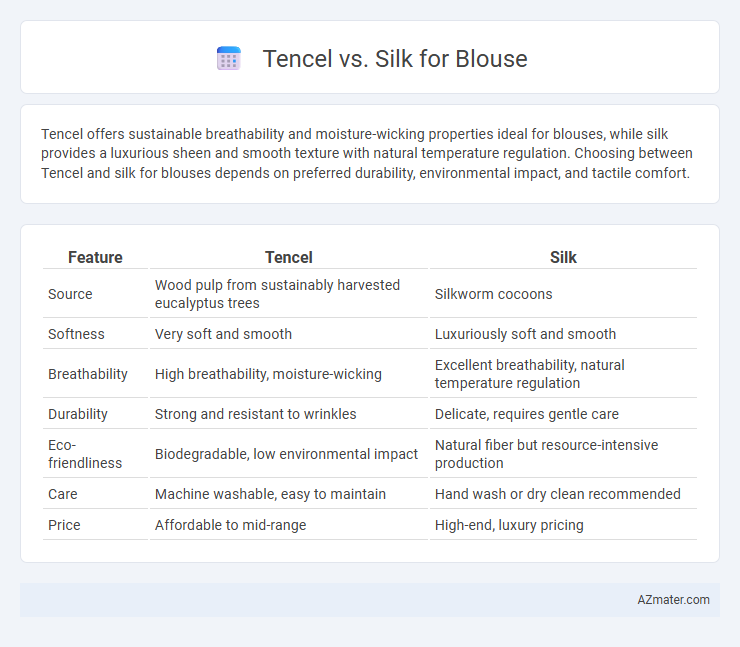Tencel offers sustainable breathability and moisture-wicking properties ideal for blouses, while silk provides a luxurious sheen and smooth texture with natural temperature regulation. Choosing between Tencel and silk for blouses depends on preferred durability, environmental impact, and tactile comfort.
Table of Comparison
| Feature | Tencel | Silk |
|---|---|---|
| Source | Wood pulp from sustainably harvested eucalyptus trees | Silkworm cocoons |
| Softness | Very soft and smooth | Luxuriously soft and smooth |
| Breathability | High breathability, moisture-wicking | Excellent breathability, natural temperature regulation |
| Durability | Strong and resistant to wrinkles | Delicate, requires gentle care |
| Eco-friendliness | Biodegradable, low environmental impact | Natural fiber but resource-intensive production |
| Care | Machine washable, easy to maintain | Hand wash or dry clean recommended |
| Price | Affordable to mid-range | High-end, luxury pricing |
Introduction: Tencel vs Silk for Blouses
Tencel and silk are popular fabrics for blouses, each offering distinct benefits based on their fiber properties. Tencel, derived from sustainably sourced eucalyptus wood pulp, provides a soft, breathable, and moisture-wicking fabric ideal for comfort and environmental consciousness. Silk, a natural protein fiber produced by silkworms, is prized for its luxurious texture, natural sheen, and excellent temperature regulation, making it a premium choice for elegant and breathable blouses.
Fabric Origins: How Tencel and Silk are Made
Tencel fabric originates from sustainably sourced wood pulp, primarily eucalyptus, beech, and spruce trees, processed through a closed-loop system that recycles water and solvents, minimizing environmental impact. Silk is produced from the natural protein fiber secreted by silkworms during cocoon formation, harvested through traditional sericulture methods that require meticulous care and labor-intensive processes. The contrasting production methods highlight Tencel's eco-friendly, cellulose-based origins versus silk's animal-derived protein fiber, influencing their environmental footprint and fabric characteristics.
Texture and Feel: Comparing Comfort
Tencel offers a smooth, soft texture with excellent moisture-wicking properties, making it breathable and comfortable for all-day wear. Silk provides a luxurious, silky feel that is naturally hypoallergenic and temperature-regulating but can be less breathable in humid conditions. Both fabrics deliver premium comfort, with Tencel excelling in softness and moisture control, while silk stands out for its elegant sheen and natural cooling effect.
Breathability and Moisture Management
Tencel fabric offers superior breathability and moisture management compared to silk, making it ideal for blouses worn in warm or humid conditions. Its fiber structure efficiently wicks moisture away from the skin, promoting quick evaporation and keeping the wearer cool and dry. While silk provides natural temperature regulation, it tends to retain moisture longer, which can result in less effective breathability during extended wear.
Durability and Longevity
Tencel fibers are known for their high tensile strength and resistance to wear, making them more durable and long-lasting compared to silk. While silk offers a luxurious feel and natural sheen, it is more delicate and prone to damage from friction and exposure to sunlight. For blouses, Tencel provides greater longevity with easy care, maintaining its shape and color over extended use, whereas silk requires gentle handling to preserve its quality.
Eco-Friendliness and Sustainability
Tencel, derived from sustainably managed eucalyptus trees, offers superior eco-friendliness by using less water and energy during production compared to conventional fabrics, and its closed-loop manufacturing process significantly reduces chemical waste. Silk, although biodegradable and natural, often involves intensive water and resource consumption as well as ethical concerns related to silkworm farming. Choosing Tencel over silk for blouses supports a lower environmental footprint and aligns with sustainable fashion principles emphasizing renewable fibers and responsible production methods.
Care and Maintenance Requirements
Tencel blouses require gentle machine washing or hand washing with mild detergent, and they dry quickly without the risk of shrinking. Silk blouses need delicate hand washing or dry cleaning to preserve their natural sheen and avoid damage from harsh chemicals or agitation. Both fabrics benefit from air drying and low-heat ironing, but silk demands extra care to prevent discoloration and fiber degradation.
Style and Draping Qualities
Tencel blouse fabric offers a smooth, matte finish with excellent draping that contours softly to the body, creating an effortlessly chic and modern look. Silk blouses provide a luxurious sheen and fluid drape that enhance elegance and sophistication, with a natural luster that catches light beautifully. Both materials excel in style versatility, but Tencel delivers superior breathability and wrinkle resistance, while silk maintains timeless glamour and a delicate, flowing silhouette.
Cost Comparison: Tencel vs Silk Blouses
Tencel blouses generally cost between $30 to $80, offering an affordable yet luxurious alternative to silk blouses, which typically range from $100 to $300 or more depending on the quality and brand. The lower production cost and sustainable manufacturing process of Tencel contribute to its budget-friendly pricing, while silk's natural fiber and labor-intensive harvesting drive its higher price point. Consumers seeking cost-effective, eco-conscious options often prefer Tencel, whereas those prioritizing traditional luxury and softness may invest in higher-priced silk blouses.
Choosing the Best Fabric: Tencel or Silk?
Tencel offers exceptional moisture-wicking properties, breathability, and eco-friendly production, making it ideal for blouses that prioritize sustainability and comfort. Silk boasts a luxurious sheen, smooth texture, and natural temperature regulation, perfect for elegant, formal wear. Choosing between Tencel and Silk depends on whether durability and environmental impact or timeless luxury and delicate feel are your main priorities for a blouse.

Infographic: Tencel vs Silk for Blouse
 azmater.com
azmater.com